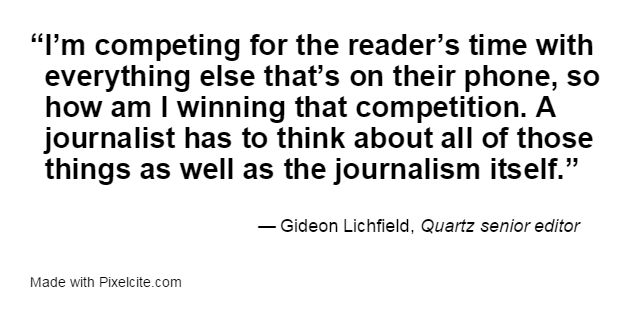HUESCA, Spain -- A digital business publication like Quartz — or qz.com — would seem to be making all the right moves. In just over two years it built an audience of 10.9 million unique users a month.
But the struggle is to continue growing amid heavy competition and to start turning a profit. So Quartz's senior editor, Gideon Lichfield, was looking for answers and ideas just like the other 350 journalists, professors and students attending the XVI Digital Journalism Congress. He was also on the program to talk about Quartz, including its plans for expansion into Africa.
Win the competition
Lichfield worked for The Economist for 16 [years] and knows both the print and digital worlds. Digital requires journalists to think more about the audience, he told me in an interview. "How people consume the journalism, how it reaches them, when they're reading it and so forth, that is completely different," he said. "In a print magazine, you don't really think about any of that. The formats are set.
"In digital, every journalist also has to be a user-experience designer to some extent. They have to be thinking about how someone is going to come across my article, what's going to make them read it, what's going to make them share it, what's going to make them get to the end. What sort of device are they going to be reading it on? What time of day might they be reading it? What methods could I be using other than text to get my point across more clearly, more efficiently?"
Facebook as a competitor
I asked Lichfield if he was worried about the fact that Facebook and other social networks are using news content from sites like his own to capture and hold onto users. (Quartz's president is also worried that users are consuming Quartz content outside the site.)
It is a love-hate relationship, he admitted. Facebook drives more traffic to their site than any other source. So they will write one headline on an article designed to appeal to Facebook users and another for their website and Twitter.
Among the strategies to build user loyalty and counter the Facebook effect are a news update that gives any visitor to Quartz the chance to read the latest news headlines and perhaps click on a few more stories.
And as with many other digital sites competing for traffic, they try to be in as many channels as possible. One is an email newsletter sent out every morning to 110,000 users with the editors' selection of a half-dozen important stories to follow. Often only one is by Quartz, Lichfield said. But the email is designed to brand Quartz as a source of quality coverage and bring people back.
Going long
Lichfield is not really interested in talking about the ideal length of stories. For him, it is all about quality and variety. The site's content is divided not by sections but by the 50 journalists' "obsessions." So some articles on the site touch on popular topics like children and their education. But some "wonky" topics that their reporters obsess about, like the European Central Bank or China's monetary policy, will have a narrow audience.
The important thing for their advertisers is that their message is always going to appear next to intelligent material, Lichfield said.
I asked him if he had any advice for students of journalism and young professionals. Lichfield replied that he once wrote a column telling young people not to ask him for advice. The best advice he ever got was to network with people your own age or slightly older, because they have just gone through what you're about to go through. "The world I grew up in is just too different from the world they're growing up in."
Lichfield spoke to me in English, but on stage he spoke in fluid Spanish. He picked it up while heading The Economist's Mexico City bureau.
This post originally appeared on James Breiner's blog News Entrepreneurs and is republished on IJNet with permission.
James Breiner is a former ICFJ Knight Fellow who launched and directed the Center for Digital Journalism at the University of Guadalajara. Visit his websites News Entrepreneurs and Periodismo Emprendedor en Iberoamérica.
The cropped main image is CC-licensed on Flickr via webtreats

